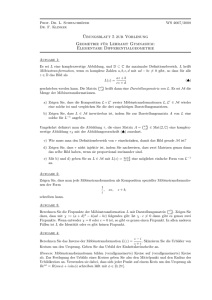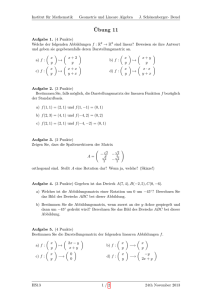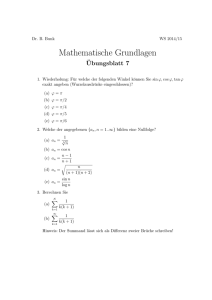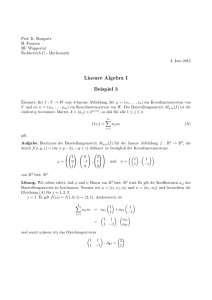Lösungen ¨Ubung 11 - Institut für Mathematik
Werbung
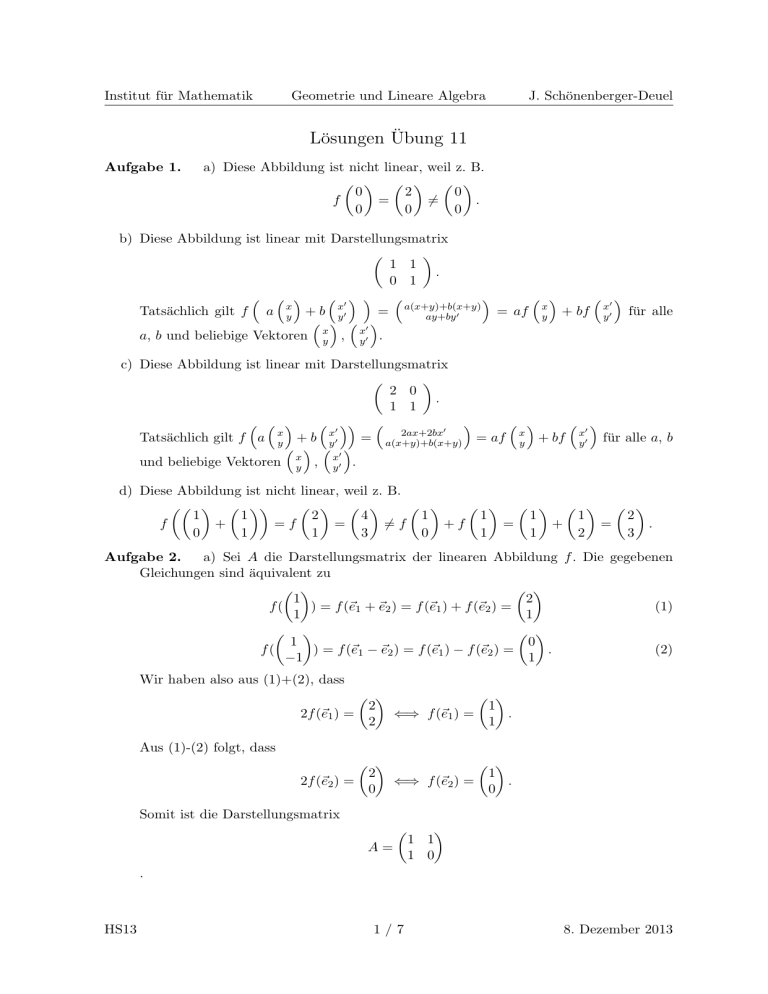
Institut für Mathematik Geometrie und Lineare Algebra J. Schönenberger-Deuel Lösungen Übung 11 Aufgabe 1. a) Diese Abbildung ist nicht linear, weil z. B. 0 2 0 f = 6= . 0 0 0 b) Diese Abbildung ist linear mit Darstellungsmatrix 1 1 . 0 1 0 0 x x Tatsächlich gilt f a xy + b xy0 = a(x+y)+b(x+y) = af + bf für alle y y0 ay+by 0 0 a, b und beliebige Vektoren xy , xy0 . c) Diese Abbildung ist linear mit Darstellungsmatrix 2 0 . 1 1 0 0 2ax+2bx0 Tatsächlich gilt f a xy + b xy0 = a(x+y)+b(x+y) = af xy + bf xy0 für alle a, b 0 und beliebige Vektoren xy , xy0 . d) Diese Abbildung ist nicht linear, weil z. B. 1 1 2 4 1 1 1 1 2 f + =f = 6= f +f = + = . 0 1 1 3 0 1 1 2 3 Aufgabe 2. a) Sei A die Darstellungsmatrix der linearen Abbildung f . Die gegebenen Gleichungen sind äquivalent zu 2 1 ) = f (~e1 + ~e2 ) = f (~e1 ) + f (~e2 ) = (1) f( 1 1 0 1 f( ) = f (~e1 − ~e2 ) = f (~e1 ) − f (~e2 ) = . (2) 1 −1 Wir haben also aus (1)+(2), dass 2f (~e1 ) = 2 1 ⇐⇒ f (~e1 ) = . 2 1 Aus (1)-(2) folgt, dass 2 1 2f (~e2 ) = ⇐⇒ f (~e2 ) = . 0 0 Somit ist die Darstellungsmatrix 1 1 A= 1 0 . HS13 1/7 8. Dezember 2013 Institut für Mathematik Geometrie und Lineare Algebra J. Schönenberger-Deuel b) Sei B die Darstellungsmatrix von f . Auf die gleiche Weise wie in (a) erhalten wir 2 4 f( ) = f (2~e1 + 3~e2 ) = 2f (~e1 ) + 3f (~e2 ) = 3 1 −4 0 f( ) = −4f (~e1 ) + 2f (~e2 ) = . 2 2 (3) (4) Wir haben also aus 2(3)+(2), dass f (~e2 ) = 1 . 1/2 Aus (3) folgt, dass f (~e1 ) = 1/2 . −1/4 Somit ist die Darstellungsmatrix B= 1/2 1 −1/4 1/2 . c) Eine solche lineare Funktion f existiert nicht: Einerseits ist nach Definition f (−4, −2) = (0, 1), andererseits folgt aus der Linearität, dass f (−4, −2) = −2f (2, 1) = −2(2, 1) = (−4, −2). Aufgabe 3. Die Spalten sind orthogonal, genau dann wenn der Skalarprodukt gleich null ist. Hier gilt √ √ − 2 − 2 √ 2 · √2 = 1 − 1 = 0. 2 2 2 − 2 2 √ Weil − 2 2 = cos (135◦ ), √ 2 2 2 = sin (135◦ ), erhalten wir die Rotationsmatrix R0, 135◦ = HS13 cos (135◦ ) − sin (135◦ ) sin (135◦ ) cos (135◦ ) 2/7 . 8. Dezember 2013 Institut für Mathematik Geometrie und Lineare Algebra √ Aufgabe 4. trix a) Weil 2 2 R0, −45◦ Denn = cos (−45◦ ), − J. Schönenberger-Deuel √ = sin (−45◦ ), erhalten wir die Rotationsma√ √ ! 2 2 cos (−45◦ ) − sin (−45◦ ) 2√ √2 = . = ◦ ◦ sin (−45 ) cos (−45 ) − 22 22 2 2 √ ! 2 2 7.78 ~ ◦ R0, −45 OA = , ≈ −2.12 2 2 − √72 √ ! √5 − 2 2.12 2 ~ √ ◦ R0, −45 OB = , ≈ √5 + 2 4.95 2 √ −3√2 −4.24 ~ R0, −45◦ OC = . ≈ −4.24 −3 2 √7 + 2 √ b) Die Spiegelung an der y-Achse bildet den Vektor xy auf den Vektor −x ab. Die y Darstellungsmatrix lautet −1 0 M= . 0 1 Die Verknüpfung der zwei Abbildungen ist N = R0, −45◦ · M = Daraus folgen ~ = N OA HS13 − √12 √1 2 √1 2 √1 2 ! . ! √ 2 2 − √72 −2.12 √ ≈ , √7 + 2 2 7.78 2 3/7 8. Dezember 2013 Institut für Mathematik Geometrie und Lineare Algebra J. Schönenberger-Deuel √ ! + 2 4.95 ~ √ N OB = ≈ , 2.12 − 2 √ −4.24 −3√2 ~ ≈ N OC = −4.24 −3 2 √5 2 √5 2 . Aufgabe 5. a). Diese Abbildung ist linear mit Darstellungsmatrix 2 −1 . 1 1 b). Diese Abbildung ist linear mit Darstellungsmatrix 1 0 . 0 1 c). Diese Abbildung ist linear mit Darstellungsmatrix 0 0 . 0 0 d). Diese Abbildung ist linear mit Darstellungsmatrix 0 −1 . 2 1 Aufgabe 6. a) Wie in Aufgabe 3, ist die Rotationsmatrix R0, 45◦ = cos (45◦ ) − sin (45◦ ) sin (45◦ ) cos (45◦ ) √ 2 √2 2 2 = √ −√ 22 2 2 ! . Die Inverseabbildung ist die Rotation um −45◦ , welche Matrix wie folgt aussieht: √ ! √ R0, −45◦ = HS13 4/7 2 2√ − 2 2 2 √2 2 2 . 8. Dezember 2013 Institut für Mathematik Geometrie und Lineare Algebra J. Schönenberger-Deuel b) ~ = Sei OC a b 0 beliebig. Die Dreiecke ACD und AC 0 D sind ähnlich, weil C die Spiege~ = b , und die Abbildung besitzt lung von C and der Gerade y = x ist. Deswegen OC a die Matrix 0 1 . 1 0 Diese Matrix ist invertierbar, und wir sehen es einfach ein, weil 0 1 1 0 II ↔ I 1 0 0 1 1 0 0 1 . 0 1 1 0 Die Inverseabbildung besitzt die gleiche Darstellungsmatrix, d. h. 0 1 1 0 . c) Da tan(45◦ ) = 1, ist die Darstellungsmatrix dieser Abbildung laut dem Skript 8.4 1 1 . 0 1 Diese Matrix ist invertierbar, und wir sehen es einfach ein, weil 1 1 1 0 I ← I − II 0 1 0 1 1 0 1 −1 . 0 1 0 1 Die Inverseabbildung besitzt die gleiche Darstellungsmatrix, d. h. HS13 5/7 1 −1 0 1 . 8. Dezember 2013 Institut für Mathematik Geometrie und Lineare Algebra J. Schönenberger-Deuel d) Da f (~e1 ) = f (~e2 ) = 1/2 1/2 erhalten wir die Darstellungsmatrix 1 A= 2 Also Aufgabe 7. 1 1 1 1 x+y x x 2 = x+y =A f . y y 2 a) Wie in Aufgabe 6 b). b) rr HS13 6/7 8. Dezember 2013 Institut für Mathematik Geometrie und Lineare Algebra J. Schönenberger-Deuel Zuerst drehen wir g bis sie mit der x-Achse zusammenfällt.√Sei α der Winkel der √Gerade g. Wir sehen, dass aus tan α = 1/2 folgen cos α = 2/ 5 und sin α = 1/ 5. Dies entspricht einer Rotation von α, welche Darstellungsmatrix √ √ 2/√5 −1/√ 5 R0, −α = . 1/ 5 2/ 5 ist. Die gesuchte Spiegelung ist nun eine Spiegelung an der x-Achse, welche Darstellungsmatrix 1 0 A= . 0 −1 ist. Wir drehen dann die x-Achse zurück mit Darstellungsmatrix √ √ 2/ √5 1/√5 . R0, α = −1/ 5 2/ 5 . Die Komposition der Abbildungen R0, α ◦ Sx ◦ R0, −α ist die Darstellungsmatrix der Funktion: R0, −α · A · R0, α = √ √ √ √ 2/ √5 1/√5 1 0 2/√5 −1/√ 5 = · · = 0 −1 −1/ 5 2/ 5 1/ 5 2/ 5 1 3 4 = 5 4 −3 0.6 0.8 . 0.8 −0.6 Alternativ könnte man α 1 3 cos 2α cos − sinα f (~e1 ) = = = , 2 sin α cos α sin 2α 5 4 1 4 sin 2α f (~e2 ) = = − cos 2α 5 −3 berechnen. Dies definiert auch die Darstellungsmatrix. HS13 7/7 8. Dezember 2013
